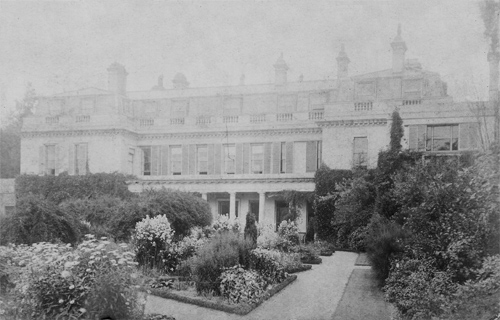Chipstead Place
Kent
| Location | Chipstead | ||
| Year demolished | 1932 | ||
| Reason | Surplus to requirements, then urban development | ||
| See all images: | Gallery | ||
| << Back to the main list |
Text written by, and copyright of, David Poole - House and Heritage - many thanks
Chipstead Place was once part of the demesne and lands of the manor of the de Chepsted family. It was first mentioned in the latter end of the reign of Elizabeth I, when it was in the possession of Robert Cranmer, the son of Thomas, who married Jane Grace, daughter of a Sussex landowner.
 Anne, their only daughter, carried the seat in marriage to Sir Arthur Herrys, eldest son of Sir William Herrys, in Essex. On the death of Sir Arthur in 1632 the estate passed to his second son, John, who married the daughter of Sir Thomas Dacre, of Chestnut, in Herefordshire. The lady survived him and married William Priestly, of Wild Hill, in Hertfordshire, who in 1652 conveyed Chipstead Place to one Jeffry Thomas.
Anne, their only daughter, carried the seat in marriage to Sir Arthur Herrys, eldest son of Sir William Herrys, in Essex. On the death of Sir Arthur in 1632 the estate passed to his second son, John, who married the daughter of Sir Thomas Dacre, of Chestnut, in Herefordshire. The lady survived him and married William Priestly, of Wild Hill, in Hertfordshire, who in 1652 conveyed Chipstead Place to one Jeffry Thomas.
Subsequently it became the property of David Polhill, who was High Sheriff in 1662, and dying without issue, left the estate to his only surviving brother, Thomas Polhill, of Clapham, in Surrey. By his marriage with Elizabeth, daughter of Henry Ireton, he left three sons but, by a will, he conveyed the house in 1665 to Sir Nicholas Strode. A new house was erected here by William Emerton around the turn of the 18th century. A grand affair with 26 bed and dressing rooms and six reception rooms.
David Polhill, son of Thomas Polhill, later re-purchased Chipstead Place from Emerton trustees, and was a member for the county in Parliament in 1708 and Keeper of the Records and Sheriff of Kent in 1715. Once again, the house had come into the possession of the Polhill family. In 1754 Charles Polhill resided here and it later became home to other members of the family.
Frederick Perkins built an estate village here in 1729, and on his death in 1860, the family tenanted the house, including to railway builder Sir Samuel Morton Peto and the banker Henry Oppenheim.
Subsequently it was the home to John Duveen, who during World War One, lent Chipstead Place as a hospital for wounded soldiers. The first batch of Belgian soldiers who bore the brunt of the German attack on the forts of Liege and Namur were received here and nursed by ladies of the district who formed the local detachment of the V.A.D., under Miss Hall Hall, the Commandant. During this period Chipstead Place was visited by thousands of local people admiring the stately mantlepieces, the pictures and other glories of the fine old mansion. After the war, Mr Duveen sold the house to Sir Roland Hodge, who later disposed of it to Dame Adele Meyer.
After a sale of contents in 1931, Chipstead Place went under the hammer ‘for demolition’. “Thus, there passes a familiar landmark, another sacrifice on the altar of ‘development’ a sacrifice even more complete than has overtaken other mansions in the district,” reported the Sevenoaks Chronicle and Kentish Advertiser.
Chipstead Place was demolished in 1932 and its land used to build new houses. Only the ballroom, servants’ quarters and West Lodge survived. Part of the estate is now occupied by Chipstead Place Lawn Tennis Club.